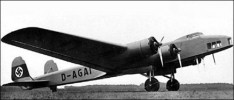
Dornier Do 191255 viewsAlong with the Junkers Ju 89, the Do 19 was developed as part of the "Ural Bomber" program championed by Gen. Walther Wever who forsaw the need for long range strategic bombing capability. When Gen. Wever was killed in April of 1936, the goal of a strategic bombing capability died with him. On April 29, 1937, the Ural-Bomber bomber program was cancelled by Kesselring in spite of protests. Kesselring felt the production and development resources would be better used to develop and build tactical bombers such as the Do 17 and He 111. This philosophy would later haunt and severely handicap the Luftwaffes ability to strike at Russia's production capabilities.Sep 18, 2006
|
|
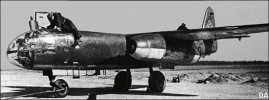
Arado Ar 2401178 viewsThe German Arado 234 was the very first purpose-built jet bomber. While the Ar-234 had very little influence on the outcome of World War II, being much too late and too few in number, it had influence on later aircraft designs. The Ar-234B could be configured either as a bomber or reconnaissance aircraft. It weighed about 5.2 tonnes (11,464 pounds) empty, and about 8.43 tonnes (18,850 pounds) fully loaded. Maximum bomb load was about 1.5 tonnes, carried externally. When used as a reconnaissance aircraft, the AR-234B carried a pair of 300 liter (79 US gallon) drop tanks in place of the bombs.
The powerplants consisted of a pair of Junkers Jumo 004B turbojets, with 900 kilograms (1,980 pounds) thrust each. Maximum speed without bombs or drop tanks was 740 KPH (460 MPH) at 6,100 meters (20,000 feet), but the speed dropped to as low as 660 KPH (410 MPH) with external loads. The prototypes had actually been a good 30 KPH faster than the Ar-234B, due to the more slender fuselage allowed by the lack of landing gear. Tricycle landing gear was fitted. As the Ar-234 landed at high speed, it had a drag chute as standard equipment; it was one of the first aircraft to do so. The rounded nose of the aircraft was covered with plexiglas, giving the pilot an excellent view to the front, but no view to the back except through a periscope. The periscope, which was not provided in the Ar-234 prototypes, also served as a sight for dive-bombing attacks. As a bomber, the Ar-234 was something of a failure. It could not carry enough of a bombload to match the destructive power of the big heavy bombers that were smashing the Reich. However, as a reconnaissance aircraft it proved able to bring back intelligence from airspace denied to prop-driven aircraft.
There were also a number of innovations in the Ar-234 that would be seen in later aircraft. Sep 18, 2006
|
|
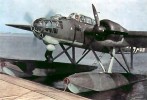
Heinkel He 115489 viewsThe He 115, constructed as a twin engine plane was very effective in it's role as mine-layer and torpedo-bomber (first flight in 1936).
In 1940 the He 115B saw service as a mine-layer, carrying a single magnetic mine of 920 kg. Airplanes of Küstenfliegergruppe 106 und 406 flew on a regularly basis mining missions at the east and south coast of Great Britain. At the end of 1940 the He 115 C appeared with heavy armament; a subversion had improved skids for landings on ice and iced snow. The C-4 was a version specialised for torpedo-attacks, which was used several times against the north-cape convoys. Sep 24, 2004
|
|
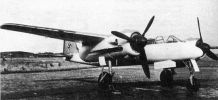
Focke Wulf TA154 Moskito1133 viewsThe Ta154 was developed because the Mosquito night bombers were almost invulnerable for a long time. The airframe was made of wood, a quite unusual feature for a german frontline aircraft, and there was just one production plant for a suitable glue, which was destroyed by a bombing raid. Instead, another glue was used, which caused some damage to nearby wood. This was the reason why Tank cancelled the quantity production after 8 prototypes, 7 pre-serial planes and only 10 serial planes until a better glue was available (indeed, there was none). Another weakness was the bow-wheel landing gear, which caused some crashes. Interesting was the method how the stability of the structure at high speeds was tested; they dragged a hull through water at high speed! The Ta154C was supposed to make use of the modern 1750PS Jumo213 engines.
Sep 23, 2004
|
|

Messerschmidt Me 410 Hornisse780 viewsThe Me 410, was an improvement of the Me 210 proposed as a high altitude fighter/bomber with two DB 603A engines (1750 hp), wing edge slats, a presurized cabine, lengthened engine nacelles and no sweep back on the wings. The Me 410 was waited everywhere in all fronts by 1943 and arrived too late. When it finally arrived, it was usually limited to the role of high-speed bomber or reconnaissance. The Hornisse was more successful in Observation units 1 and 7 than in the interceptor role.
The first prototype V1 was ready by the end of 1942. The entire test program envolved some twenty test planes many of which were modified Me 210s. The armament was the same as in the Me 210.
Sep 23, 2004
|
|
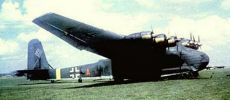
Messerschmitt Me 323759 viewsA powered derivative of the Me 321, the Me 323 proved to be a successful aircraft. Several variants were produced including a Gunship and bomber. This vulnerable transport suffered heavily at the guns of Allied fighters. This version also carried several tonnes of armor and bulletproof glass. Eventually it was decided that escort fighters would be more effective and this version did not see wide-spread production.Sep 23, 2004
|
|
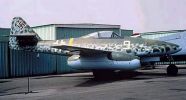
Messerschmitt Me 262 Schwalbe500 viewsThe Me 262A-1a "Schwalbe" ("Swallow") was the first production model of the Me 262. It was produced with four Mk 108 30mm cannon mounted in the nose, in its role as an interceptor, a role that it performed with great promise. it came into the battle far too late, when the Allied air forces had reached formidable capacity; secondly, its engines were a constant source of trouble, frequently failing after no more than 12 hours; the Me 262A-2a "Sturmvogel" ("Stormbird") was reconfigured to carry two 550lb bombs, still retaining the four cannon. A further refinement, Me 262A-2a/U1 had two of the cannon removed to provide space for a bomb-aiming device, and Me 262A-2/U2 carried a prone bombardier in the nose section. Thus, for much of the aircraft's brief combat life, it was used against the wrong type of targets, with even less effect than if it had been used as an interceptor.
Sep 23, 2004
|
|
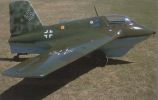
Messerschmitt Me 163B-1450 viewsAlthough the aircraft's two MK 108 30mm cannons were capable of downing a four-engine bomber with only three or four hits, the Komet's high speed, coupled with the cannons' slow rate of fire and short range made effective gunnery nearly impossible against the slow moving bombers. As a result, Me 163 pilots recorded a total of only nine kills. Although capable of reaching its service ceiling of 12,100 m (39,690 ft) in just under three-and-a-half minutes, the Me 163 carried only enough fuel for eight minutes of powered flight. An improved variant of the aircraft with a greater endurance and a tricycle landing gear, designated the Me 163 C, was also produced in small numbers before the war's end, but was not flown operationally.
Sep 23, 2004
|
|
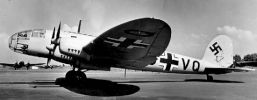
Heinkel He 116496 viewsThis aircraft was designed in 1936 as a high altitude aircraft for Lufthansa. The specified Hirth powerplants were not available and the V1 flew in 1937 on lower rated engines. Eight A-series mail carriers were built followed by the He 116R with rocket boost. The He 116R later flew 6,214 (10,000km) on June 30, 1938 non-stop. Six B-0 were delivered to the Luftwaffe in 1938 as long range photo recon aircraft but their low speed, lack of pressurization and lack of armament made them too vulnerable to use in enemy airspace and these airframes spent the remainder of their careers doing photographic work over Germany.Sep 23, 2004
|
|
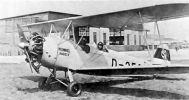
Heinkel He 72525 viewsThe Kadett was introduced in the Luftwaffe in 1933, when the latter was not yet official. It remained one of the most wideley used German primary trainers until 1944. Although it lacked power, it was a pleasant plane to fly and quite comparable to the British Tiger Moth.
Almost all Kadett were He 72B, of which the prodcution took place from 1934 until 1936. After that, only models with a limited number of examples remained in production (He 72BW, He 72B-3). A single example was tested by the Japanese Navy as the "KXHe1"
Sep 23, 2004
|
|
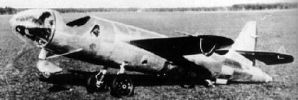
Heinkel He 176705 viewswas the world’s first aircraft to be propelled solely by a liquid-fuelled rocket, making its first powered flight on July 20 1939 with Erich Warsitz at the controls. The He 176 was built to utilise one of the new Walter engines. It was a tiny, simple aircraft, built almost entirely out of wood and lacking even an enclosed canopy. It had a conventional, fixed, tricycle undercarriage, but relied on the weight of the pilot to actually rest on its wheels. Empty, the tail of the plane rested on the ground. Heinkel demonstrated the aircraft to the RLM, but official disinterest led to the abandonment of the company's rocket propulsion programme. The He 176 was placed in the Deutsches Technikmuseum ("German Technical Museum") in Berlin, where it was destroyed in an air raid during World War II.Sep 23, 2004
|
|
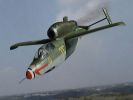
Heinkel He 162626 viewsThe Heinkel He 162 Volksjäger was the second jet engined fighter aircraft to be fielded by the Luftwaffe in WWII. It is know primarily for a series of spectacular disasters during testing. Nevertheless the ambitious production program continued and 300 were complete by the war's end, with another 100 ready for delivery. Only one gruppen had completely re-formed with the He 162 in late April, and they claimed two or three planes in combat before their base was taken over by the British in early May.Sep 23, 2004
|
|
|
|